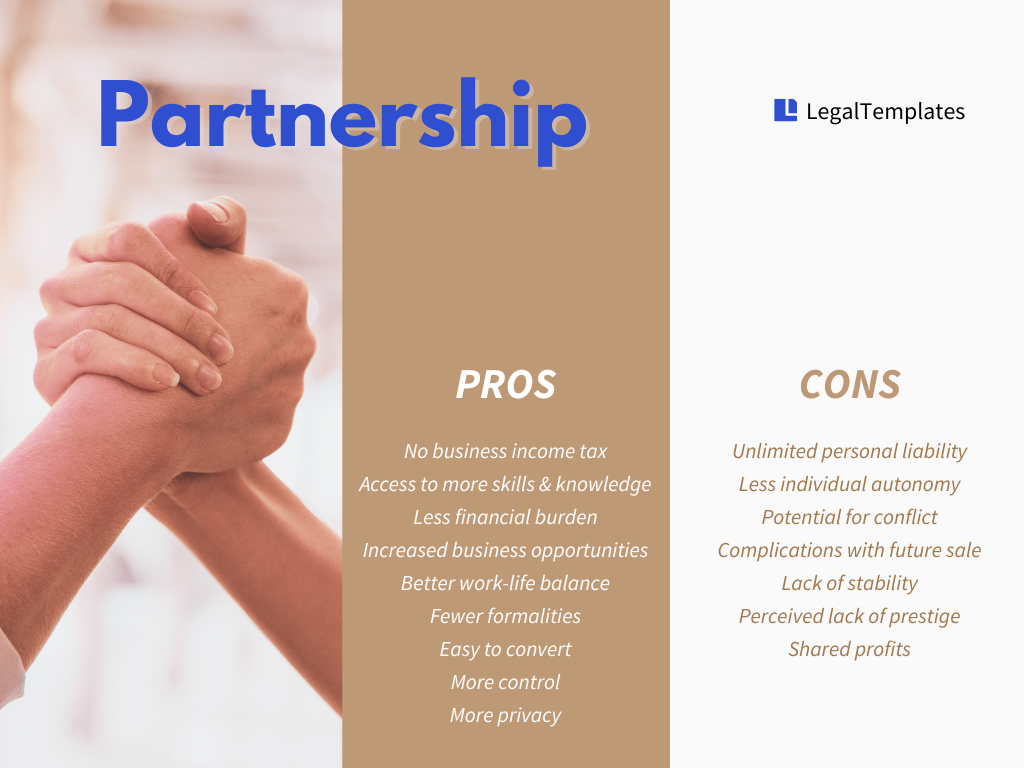Starting a partnership can be an exciting endeavor as you and your partner build your business, but it’s important to evaluate the advantages and disadvantages of a partnership before you jump right in. A partnership allows for combined knowledge, more privacy, and tax benefits, but it also comes with drawbacks like less autonomy and shared profits. Taking the time to examine the elements of a partnership can help you determine whether it’s the best choice for you.
What to Consider Before Starting a Partnership
Before you start a partnership, consider how it will align with your values, business goals, and desired level of responsibility. Ensure that you meet with your potential partners to evaluate their work styles, personality, and communication methods to see if you will mesh well together for business success. In addition, make sure you understand that you will be held liable for your partner’s successes and losses.
Once you understand how you’ll work together, you can compare the different types of partnerships to find one that meets your needs. The types of partnerships include:
- General: In a general partnership, each partner assumes equal responsibility and liability and can legally sign on behalf of the business.
- Limited: Limited partnerships include general partners who run the business and hold all liability and limited partners who only control capital and are not liable.
- Limited liability: A limited liability partnership allows each partner to choose their level of investment and involvement, and each partner is only liable for their own actions.
Legal Templates offers tools and templates for partnerships so you can easily create a partnership agreement and establish the terms of your collaboration. Begin a 7-day free trial to access customizable and downloadable forms to kickstart your partnership.

10 Advantages of a Partnership
Establishing a partnership has many advantages that extend beyond just having the support and resources of one or more additional partners. Some other pros of a partnership include saving on taxes, complementary skills, reduced financial burdens, additional business opportunities, greater control, and more.
1. No Additional Business Taxes
Although partnerships must file a 1065 Form with the IRS about their annual financial performance, they don’t have to pay income tax at a business level. This form works only to provide the government with information about the partnership’s financial records.
A partnership serves as a “pass-through” entity for taxes. This means that the profits and losses apply directly to each partner and must be included on their individual income tax returns. Filing partnership expenses or income at the individual level reduces the additional costs or fees applied to other businesses.
2. Access to Complementary Skills & Knowledge
In a partnership, everyone involved can benefit from having a group with complementary skills and knowledge. Each person may fill in a gap or have a specific role within the group. This creates a well-rounded system for handling the wide array of business tasks.
For example, you may have experience in sales and business development, whereas your other partners might be certified accountants or expert marketers. With our template, you can designate responsibilities, titles, or roles for each partner within the initial partnership agreement.
A joint venture also allows you to combine the skills, knowledge, and resources of two or more parties and companies.
3. Less Financial Burden
Overhead expenses present one of the biggest challenges of building a new business, making a partnership an attractive option. In a partnership, startup costs and other expenses are shared among business partners. You can use our template to clarify capital contributions and make it clear who is contributing what.
Additionally, having multiple partners enhances the company’s borrowing capacity as the risk is distributed among partners. Banks and other financial institutions may be more inclined to extend credit to partnerships than to sole proprietorships.
4. More Business Opportunities
A partnership provides more business opportunities as your partners can contribute stronger financial resources. In addition, partners with more experience or expertise in other areas bring industry knowledge and connections. Pooling resources and contacts from all partners increases your business opportunities, such as expanding into a new market or developing a new product.
5. Better Work-Life Balance
A partnership allows you to split responsibilities and rely on partners as necessary. Having more people to handle the work means that you can take time off for personal matters and improve your work-life balance. You can add information about your desired availability and level of responsibility in your partnership agreement using our template.
6. A Second Perspective
Business owners often get tunnel vision, focusing only on immediate challenges and missing out on potential solutions. A partner brings a fresh set of eyes and their unique experiences and ideas. Having diversity in thought and approach can lead to innovative solutions and significant growth.
7. Fewer Obligations & Formalities
Unlike limited liability companies and corporations, some states do not require partnerships to register with the Secretary of State. Most states legally recognize partnerships once they begin business operations. Our state-specific partnership agreement templates can provide information about which state laws govern your partnership.
There are also fewer ongoing requirements to comply with for a partnership when compared to the regulations for other businesses. For example, all LLCs require a registered agent, and most states require LLCs to submit annual or biennial reports with a filing fee. However, if your state does not require a business partnership to be registered, it can take minimal maintenance.
All partnerships must comply with licensing and tax requirements that apply to all businesses, regardless of whether registering with the Secretary of State is required.
8. Easy to Convert to Other Business Structures
If you decide you need more protection for your business later on, you can easily convert your partnership into a limited liability company (LLC). These two business entities have similar structures of shared decision-making and flexible management. The transition process is not overly complex, with most states providing clear guidelines and forms.
Legal Templates can provide you with an LLC agreement template so you can easily take your partnership to a new level.
9. More Control
While a limited company might be subject to the demands of shareholders or a board of directors, a business partnership offers more freedom. Members answer only to one another and don’t need to worry about external decision-makers. Your preferred decision-making processes can be outlined in your partnership agreement with our template.
Using a memorandum of understanding to draft and negotiate the terms and roles of your partnership helps you find a balance that works for your partnership.
10. Privacy & Confidentiality
Partnerships typically only require you to file tax returns and certain private tax documents with the IRS. This provides an added layer of privacy not seen in corporations, which must file annual reports or statements with the state or for shareholders and the public.
7 Disadvantages of a Partnership
A partnership can work quite well when everyone involved in the business agrees and contributes. However, certain factors can be seen as cons of a partnership. You can counteract some of these disadvantages by establishing strong terms and problem-solving processes, but it’s still important to consider the possible downsides.
1. Increased Liability
Depending on the type of partnership you agree to, your level of liability may be increased compared to other business structures. If you want to protect yourself from liability for the actions of others, you can use our partnership agreement template to create a limited liability partnership structure and dictate the specific parameters of your responsibilities.
2. Less Autonomy
Partners have equal decision-making power (unless otherwise specified in the partnership agreement). Most decisions are made jointly, so you sometimes have to compromise.
Some partners decide to allow each partner to have the sole authority to make decisions on behalf of the partnership regarding loans, purchases, or hiring. You can specify these abilities in your partnership agreement document to avoid confusing power dynamics.
3. Potential for Conflict
When associates disagree on how to run their business, it can complicate things. This is especially prominent in cases with only two partners who don’t have a tie-breaker or third-party input.
It’s important to outline how disputes will be solved in your partnership agreement. Our template allows you to include terms for problem-solving processes, such as mediation and arbitration, according to your state regulations.
You can use an arbitration agreement form to settle conflicts outside of court.
4. Complications with Future Sale
If your business receives or pursues a sale offer, it can be difficult to negotiate and agree with your partner. Having a planned exit strategy in your agreement helps. You can use our template to dictate the process for selling partnership interest, dissolving the partnership, or buying out another partner’s share. Understanding each of these options and having the terms agreed upon ahead of time reduces conflict.
5. Lack of Stability
Partnerships, known for their flexibility, lack the inherent stability of incorporated organizations. The business’s reliance on its partners means that life events like death, birth, illness, or departures can significantly impact its operations.
Make sure you discuss with your partners how to handle such life events and address them clearly in the agreement. Legal Templates’ partnership agreement template guides you through the creation of clauses for adding, removing, and transferring business ownership.
6. Perceived Lack of Prestige
For many, a formal business entity structure is a sign of prestige. While some informality can be attractive for those involved in the organization, it can worry investors or collaborators. You can try to reassure investors that your partnership is secure and stable by sharing the provisions in your agreement.
7. Shared Profits
In the same way that many partners share responsibility and work, they also share profits. In some cases, this can reduce your benefits and open the potential for conflict. By setting guidelines for profit sharing and allocating percentages of profits for each party, you can avoid disputes.
You can create a 50/50 business partnership agreement for equal profit sharing.
Do the Benefits Outweigh the Drawbacks?
Establishing a partnership is a personal decision that requires you to fully evaluate your level of comfort, accountability, and liability. Look to fully understand and weigh the different advantages and disadvantages on your own and with your potential partners. When you explore the different partnership types and evaluate the different terms you can add to your agreement, you can establish partnership guidelines that work for your situation.
Frequently Asked Questions
What is the liability of a partnership owner?
The liability of a partnership owner can vary depending on the type of partnership established. In a general partnership, the owner assumes liability for all business decisions, debts, and obligations, while a limited liability partnership owner is only responsible for their own portion.
Why is it good to be a partnership?
It can be good to establish your business as a partnership to combine multiple skill sets and share responsibility, as well as experience fewer tax requirements and more private business ownership or reports.
What business type is best for a partnership?
Partnerships are often best for small business partnerships or groups of professionals in the same industry or area of expertise, such as medical professionals, lawyers, accountants, and architects. This business structure may also be helpful for entrepreneurs who want to test their business idea before establishing a more formal entity.
What happens if a partner wants to leave the partnership
If a partner decides they want to leave the partnership, there are a few different methods, such as dissolving the partnership or allowing a buyout from another partner. The partner who is leaving must follow the method dictated in the original partnership agreement or reach a mutual agreement with the other partner.
Why do partnerships fail?
The most common issues that cause partnerships to fail include miscommunication, disagreement on goals, lack of resources, or uneven contributions from partners. Having a detailed agreement document with solutions for potential problems can help navigate these issues.
